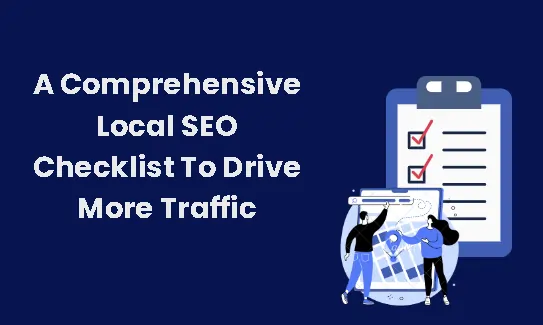Driving leads into a business is a crucial process for generating revenue. There is a high possibility of reaching those audiences when they actively search for a solution such as what you offer.
This can be achieved through local SEO. If you are targeting local audiences and haven’t optimized for them, then you‘re missing the opportunity to reach high-intent people. Your competitors will likely beat you on the SERP. Here we provide a quick and important step-by-step Local SEO Checklist guide to drive more leads
What Is Local SEO?
Local SEO is a strategy for optimizing your website and business profile to improve your visibility for related local search queries. By finding local keywords, optimizing your business profile and website page, managing reviews, etc., you can improve your local traffic and attract more high-intent leads.
Why Local SEO is still important?
For several reasons, local SEO is still matters to a website,
- Better visibility: Optimizing your profile with link building, listing in local directories, and having content related to your product or services helps Google rank you for related local searches.
- Get targeted traffic: Through this, you can attract targeted and high-value traffic.
- More foot traffic: This leads the audience to visit your physical store.
- More queries: Add the business phone number to help the customer call you to clear their queries.
- Educate and position your business: Creating content related to your product or services helps you educate the audience and position your brand.
- Competitive advantage: This makes you stand out in the market from your rivals.
Steps Local SEO Checklist to Enhance Your Traffic
Here is the 9-step local SEO checklist for attracting more high-quality traffic to your business. Let’s explore one by one:

1. Identify your targeted Local SEO Keywords
In this local seo checklist, you should start with keyword research. Before diving into any optimization, you should know your targeted keywords. Here are some best practices,
- Identify the keywords related to your business, products, and services.
- Use local search modifiers with your keywords such as “near me” or “keywords+city name”
- Targeting keywords with high search volume with low keyword difficulty enhances your chance to rank on SERP.
- Choosing long-tail keywords helps to increase your traffic.
- Use targeted keywords on your business profile and website to optimize it and help rank on SERPs.
- And also creating content for those keywords helps to educate people about your business. But you should understand the user’s intent.
- To find keywords you can use tools like Semrush, Ahrefs, and Google Keyword Planner. You can also utilize the Google search console for analysis.
- Analyzing your competitors to find keyword gaps can help to create strategies.
2. Update and Optimize Google Business Profile
Optimizing your Google Business Profile using this local seo checklist helps rank on Google Search and local pack. Here is the basic Google My Business Profile optimization checklist:
- Claim and verify your Google Business profile to obtain your business profile ID. (Google takes some time to verify your business)
- Double-check your business name, address, and business phone number.
- Choose the primary and secondary categories that best represent your business.
- Optimize your profile with the right keywords.
- Add photos and profile pictures to your business profile. Sometimes adding videos can boost user engagement.
- Include multiple locations in Google My Business where you provide your business or services.
- Provide details about business hours.
- Respond to your Google reviews properly.
- Keep all your products and services updated.
- Add business attributes or specific features.
- Utilize social media to enhance brand visibility.
To establish authority for your business, ensure all information is updated and consistent while optimizing your Google My Business.
3. Do Proper On-page optimization on Your Website
After optimizing your business profile, the next place to optimize for traffic is your website. Optimizing your website is the next item on your local SEO checklist.
- Meta title and description: Optimize each page’s meta title and description with the appropriate keyword, ensuring they are clickable and effectively convey your page’s content.
- Images: Images help to enhance user engagement on your webpage. Create unique and relevant images, and optimize them by including relevant keywords in the alt tags.
- Site architecture: build your site with simple navigation to help both Google and users find your pages easily.
- URL Structure: Keep your URLs lean and include relevant keywords.
- Schema markup: Utilizing local structured data can help your site rank for local search queries.
- Mobile-friendliness: Since most searches happen on mobile phones, ensure your site is mobile-friendly.
- Internal and external links: Use internal and external links within your content with related keywords to help users navigate easily and understand your content’s context.
- Location pages: Create pages for different locations to provide information about your service areas.
- Google Map: Consider using Google Maps on your Contact Us page to provide location information.
- Technical SEO: After completing your on-page optimization, conduct a technical SEO audit to address issues such as broken pages, redirects, and other technical issues.
4. Managing Business Reviews & Customers Testimonials
If a new user sees your business and wants to try it, their first move is to check your business’s reviews. This serves as social proof for your business, it can either make or break your reputation. This is the next section in your local SEO checklist.
Here are some tips for managing your business reviews:
- Focus on your Google reviews and optimize them for targeted keywords; this is more important than other factors.
- Ask and encourage your customers to leave more positive reviews and feedback on your business profile, social media, and other platforms.
- Provide quick responses to reviews whether they are positive or negative, but avoid deleting or turning off the in Google Business reviews.
- Updating customer reviews and testimonials on your website increases your credibility and trustworthiness.
- Optimize your business profile by incorporating your keywords in this review response.
- List your business on business review platforms such as Yelp, TripAdvisor, Amazon, etc.(related to your business niche) and encourage user reviews.
- Use customer review management tools to monitor your customer reviews. These tools come with additional features and you can receive immediate notifications once a customer posts a review.
5. Ensuring Consistent Citations Across All Platforms
The next section in this local SEO checklist is citations. It refers to the name, business address, and phone number (NAP) of a business mentioned on external websites. This helps Google understand your business’s credibility and authority.
Here are some best techniques for citation management:
- Accuracy and consistency are very important for citations. Any discrepancies here will affect your credibility, leading to a drop in ranking and traffic.
- You can use citation management tools to track your citations, make any changes, and update them quickly.
- Explore the opportunities to get more citations such as local directories, industry-specific directories, and relevant platforms.
- Focusing on acquiring citations from high-quality and authoritative sites rather than obtaining too many from low-quality sites.Bu
6. Building a Strong Social Media Presence
Another effective way to brand your business is by maintaining your social media presence. Here are some ideas for your social media presence:
- Choose social media platforms where your targeted customers are present. Adopting a multichannel strategy can help you to enhance the visibility.
- Responding promptly to the reviews and comments to show that your business is active and customer-focused.
- Consistency is crucial to maintaining visibility on social media, so consistently post content related to your business.
- Actively participate in local conversations and collaborate with other local businesses to build a good community presence.
- Utilize social media links in Google My Business to provide more information about your business to your audience.
- Use geotagging and local search keywords on your post to enhance your local search visibility.
7. Utilize the Schema Markup
Schema markup is the best way to increase your search visibility in this local SEO checklist. It provides additional context to Google, which results in rich snippets. Before implementing it you need to select the schema type.
Many types of schemas are available, allowing you to choose which result you want to appear.
8. Acquire Local Backlinks from High-Authority Websites
Utilizing local link building helps Google discover your local website pages and increases site authority. Here are some strategies to build links for your site:
- Finding backlinks providers is very important. You can join local organizations or business associations in your local area.
- Reach out to local bloggers or influencers by asking them to use your products and post about them, or you can write guest posts for their site. You may find local directories, and citations in this way.
- Obtaining backlinks from listicles is a smart way to boost your credibility.
- Other methods include sponsoring events or meet-ups in your local area, providing testimonials or reviews for other sites, and publishing articles on local news sites to get backlinks.
- Focus on obtaining backlinks from authoritative sites rather than considering the number of backlinks from poor-quality sites.
9. Monitor and Analyze Your Results for Success
After implementing all of these strategies, you should know the results of your efforts. Track keyword ranking, traffic, and call queries of your Google My Business and site to understand the impact.
Once you gathered this data, evaluate which strategies work best in specific areas. Utilize data from GA and GSC to analyze the performance and make decisions to reach a wider audience.
Wrap up
These steps help to make your business easily discoverable. However, managing them during your busy day makes this process difficult. Get expert advice to boost your traffic by checking out our Google My Business Optimization Service and getting a free Google My Business audit today!
Author
-
A Digital marketing expert with 2 Years of hands-on experience in On-page SEO, Off-page SEO, and WordPress. Currently working as a SEO Interim Manager at 7Eagles. He Completed his Master Degree MBA Specializing in Marketing and Finance. He has 2 Years of work experience in Digital Marketing Field. He Handled projects in Saas, Healthcare, Finance, Real-estate. He is strong on Handling Y.M.Y.L (Your Money Your Life) Niche projects.




